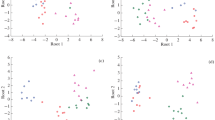Abstract
Experimental hydrocephalus was induced in rats by intracisternal injection of kaolin suspension. The amounts of norepinephrine and dopamine were determined in the whole brain and specific brain regions at 1 week (acute phase) and 4 weeks (chronic phase). The turnover of catecholamine, an index of the activity of catecholamine-containing neurons, was determined by measuring the decrease in catechlamine contents 2 h after intraperitoneal injection of α-methyl-p-tyrosine (250 mg/kg), an inhibitor of tyrosine hydroxylase. We observed that the catecholamine contents in kaolin-induced hydrocephalus were not significantly different from control values. Following injection of α-methyl-p-tyrosine, there was decrease in levels of catecholamines in both control and hydrocephalic rats. This decrease was, however, significantly less in induced hydrocephalus than in control animals. This result suggested that in hydrocephalus, the activities of norepinephrinergic and dopaminergic neurons are reduced.
Similar content being viewed by others
References
Andersson H, Roos BE (1965) Acidic monoamine metabolites in cerebrospinal fluid of children with hydrocephalus. Acta Neurol Scand 41[Suppl 13]: 149–151
Brodie BB, Costa E, Dlabac A, Neff NH, Smookler HH (1966) Application of steady state kinetics to the estimation of synthesis rate and turnover time of tissue catecholamines. J Pharmacol Exp Ther 154: 493–498
Brown RM, Kehr W, Carlsson A (1975) Functional and biochemical aspects of catecholamine metabolism in brain under hypoxia. Brain Res 85: 491–509
Chovanes GI, McAllister JP II, Lamperti AA, Salotto AG, Truex RC (1988) Monoamine alterations during experimental hydrocephalus in neonatal rats. Neurosurgery 22: 86–91
Del Bigio MR (1989) Hydrocephalus-induced changes in the composition of cerebrospinal fluid. Neurosurgery 25: 416–423
Edvinsson L, Owman C, Rosengren E, West KA (1971) Brain concentrations of dopamine, noradrenaline, 5-hydroxytryptamine, and homovanillic acid during intracranial hypertension following traumatic brain injury in rabbit. Acta Neurol Scand 47: 458–463
Ehara K, Matsumoto S, Yoshida N, Kuno T, Tanaka C (1982) Ascending norepinephrine pathways impaired in experimental hydrocephalus. Jpn J Pharmacol 32: 205–208
Gonzalez-Darder J, Barbera J, Cerda-Nicolas M, Segura D, Broseta J, Barcia-Salorio JL (1984) Sequential morphological and functional changes in kaolin-induced hydrocephalus. J Neurosurg 61: 918–924
Hashimoto K, Kikuchi H, Ishikawa M, Yokoi K, Kimura M, Itokawa Y (1990) The effect of atrial natriuretic peptide on intracranial pressure in a congenital hydrocephalic model (in Japanese). No To Shinkei 42: 683–687
Hedner J, Lundell KH, Breese GR, Mueller RA, Hedner T (1986) Developmental variations in CSF monoamine metabolites during childhood. Biol Neonate 49: 190–197
Higashi K, Asahisa H, Ueda N, Kobayashi K, Hara K, Noda Y (1986) Cerebral blood flow and metabolism in experimental hydrocephalus. Neurol Res 8: 169–176
Inagawa T, Ishikawa S, Uozumi T (1980) Homovaillic acid and 5-hydroxyindole acetic acid in the ventricular CSF of comatose patients with obstructive hydrocephalus. J Neurosurg 52: 635–641
Jones EG (1986) Neurotransmitters in the cerebral cortex. J Neurosurg 65: 135–153
Lovely TJ, McAllister JP II, Miller DW, Lamperti AA, Wolfson BJ (1989) Effects of hydrocephalus and surgical decompression on cortical norepinephrine levels in neonatal cats. Neurosurgery 24: 43–52
Miwa S (1989) Effects of congenital hydrocephalus on the content, biosynthesis and turnover of noradrenaline, dopamine and serotonin in the brain. I. Clinicopathological study (in Japanese). In: Annual Report of the Research Committee into “intractable hydrocephalus”, pp 34–38
Miwa S, Inagaki C, Fujiwara M, Takaori S (1982) The activities of noradrenergic and dopaminergic neuron systems in experimental hydrocephalus. J Neurosurg 57:67–73
Miwa S, Fujiwara M, Inoue M, Fujiwara M (1986) Effects of hypoxia on the activities of noradrenergic and dopaminergic neurons in the rat brain. J Neurochem 47:63–69
Mori K, Fujito K, Kamimura Y (1984) Binding assay for muscarinic cholinergic receptors in kaolin induced hydrocephalus (in Japanese). Nippan Geka Hokan 53:695–702
Ogura K, Shibuya M, Kanamori M, Suzuki Y, Ikegaki I, Harada T, Okada T, Tanoi C, Kageyama N (1988) Changes of monoamine neurotransmitter metabolism in brain ischemia measured by in vivo voltammetry (in Japanese). No To Shinkei 40:87–93
Onodera Y, Saitoh Y, Sakata M, Itoh H, Miwa T (1988) Quantitative fatty acid composition and monoamine metabolites in CSF from congenital hydrocephalic children during the myelination period (in Japanese). Shoni No Noshinkei 13:7–13
Owman C, Rosengren E, West KA (1971) Influence of various intracranial pressure levels on the concentration of certain arylethylamines in rabbit brain. Experientia 27:1036–1037
Sakamoto T (1989) Changes of muscarinic cholinergic receptors and cholinergic neurons in experimental hydrocephalic rat brain (in Japanese). Nippon Geka Hokan 58:80–92
Tamaki N, Yasuda M, Matsumoto S, Yamamoto T, Iriguchi N (1990) Cerebral energy metabolism in experimental canine hydrocephalus. Child's Nerv Syst 6:172–178
Ungerstedt U (1971) Stereotaxic mapping of the monoamine pathways in the rat brain. Acta Physiol Scand Suppl 367:1–48
Yamaki T, Odake G, Naruse S, Ibata Y, Nojo Y, Matsuura T (1977) Experimental hydrocephalus of the rat, produced by cisternal injection of kaolin solution (in Japanese). No Shinkei Geka 5:537–540
Author information
Authors and Affiliations
Rights and permissions
About this article
Cite this article
Miyake, H., Eghwrudjakpor, P.O., Sakamoto, T. et al. Catecholamine alterations in experimental hydrocephalus. Child's Nerv Syst 8, 243–246 (1992). https://doi.org/10.1007/BF00300789
Received:
Issue Date:
DOI: https://doi.org/10.1007/BF00300789




